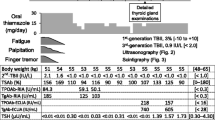Abstract
The objective of this retrospective study was to evaluate the fall in free T4 (FT4) in patients with Graves’ disease after treatment with radioiodine in a fixed dose of 600 MBq. The study was performed at our outpatient clinic with patients referred from primary care during the time period January 1989 to January 1995. Only patients not given anti thyroid drugs after radioiodine were included. FT4 and TSH were measured every second week for the first three months, and thyroxine substitution started when the FT4 was at or below 15 pmol/l. Of the 60 patients thus available for evaluation, 7 required retreatment, giving a “success rate” of 88%. Of the 53 patients successfully treated with one dose of radioiodine, 36 had not been pretreated with anti thyroid drugs. Among these patients 13 (36 %) had a transient increase in FT4 after radioiodine therapy, which mostly occurred after 4 to 6 weeks. The remaining 17 patients had been given Carbimazole prior to radioiodine. In this group 8 (53 %) had a transient increase in FT4, generally after 2 weeks. In conclusion, giving a fixed large dose of radioiodine and starting thyroxine substitution before hypothyroidism has developed is a workable clinical routine. Although a gradual fall in FT4 was the rule, a transient increase in FT4 was noticed in 30–50% of the patients 2 to 6 weeks after treatment.
Similar content being viewed by others
References
Shapiro B. Optimization of radioiodine therapy of thyrotoxicosis: what have we learned after 50 years? J. Nucl. Med. 34: 1638, 1993.
Ratcliffe G.E., Fogelman I., Maisey MN. The evaluation of radioiodine therapy for thyroid patients using a fixed-dose regime. Br. J. Radiol. 59: 1105, 1986.
Kendall-Taylor P., Keir MJ., Ross WM. Ablative radioiodine therapy for hyperthyroidism: long term follow-up study. Br. Med. J. 289: 361, 1984.
Greig W.R. Radioactive iodine therapy for thyrotoxicosis. Br. J. Surg. 60: 758, 1973.
Hagen G.A., Ouellette R.P., Chapman E.M. Comparison of high and low dosage levels of 131I in the treatment of thyrotoxicosis. N. Engl. J. Med. 277: 559, 1967.
Nordyke R.A., Gilbert F.I. Optimal iodine-131 dose for eliminating hyperthyroidism in Graves disease. J. Nucl. Med. 32: 411, 1991.
Masri M.T., Menne M., Rooney B.L., Caplan R.H. A simplified method for treating Graves’ disease with radioactive 131I Wis. Med. J. 94: 21, 1995.
Zaini A., Khir A., Doi S.A.R., Chan S.P., Paramsothy M., Khoo B.H. Results of long-term follow-up after compensated fixed-dose therapy for thyrotoxicosis. J. Int. Med. Res. 20: 279, 1992.
Franklyn J.A., Daykin J., Drolc Z., Farmer M., Sheppard M.C. Long-term follow-up of treatment of thyrotoxicosis by three different methods. Clin. Endocrinol. 34: 71, 1991.
Cunnien A.J., Hay I.D., Gorman C.A., Offord K.P., Scanion P.W. Radioidine-induced hypothyroidism in Graves’ disease: Factors associated with the increasing incidence. J. Nucl. Med. 23: 978, 1982.
McDermott M.T., Kidd G.S., Dodson L.E., Hofeldt F.D. Radioiodine-induced thyroid storm. Case report and literature review. Am. J. Med. 75: 353, 1983.
Taher M.A., Loken M.K., Bantle J.P. Radioiodine therapy in thyroxicosis. J. Indian Med. Assoc. 89: 86, 1991.
Uy H.L., Reasner C.A., Samuels M.H. Pattern of recovery of the hypothalamic-pituitary-thy-roid axis following radioiactive iodine therapy in patients with Graves’ disease. Am. J. Med. 99: 173, 1995.
Bertelsen J., Herskind A.M., Sprogøe Jakobsen U., Hegedus L. Is standard 555 MBq 131I-therapy of hyperthyroidism ablative? Thyroidol. Clin. Exp. 4: 103, 1992.
Wise P.H., Burnet R.B., Ahmad A., Harding P.E. Intentional radioiodine ablation in Graves’ disease. Lancet ii: 1231, 1975.
Eriksson E., Eriksson K., Wahlberg P. Treatment of hyperthyroidism with standard doses of radioiodine aiming at ablation. Acta Med. Scand. 217: 55, 1985.
Peters H., Fischer C., Bogner U., Reiners C., Schleusener H. Radioiodine therapy of Graves’ hyperthyroidism: standard vs calculated 131iodine activity. Results from a prospective, randomized, multicentre study. Eur. J. Clin. Invest. 25: 186, 1995.
Jarløv A.E., Hegedus L., Gjørup T., Hansen J.E.M. Accuracy of the clinical assessment of thyroid size. Dan. Med. Bull. 38: 87, 1991.
Burch H.B., Solomon B.L., Wartofsky L., Burman K.D. Discontinuing antithyroid drug therapy before ablation with radioiodine in Graves’ disease. Ann. Intern. Med. 121: 553, 1994.
Sawers J.S.A., Toft A.D., Irvine W.J., Brown N.S., Seth J. Transient hypothyroidism after iodine-131 treatment of thyrotoxicosis. J. Clin. Endocrinol. Metab. 50: 226, 1980.
Author information
Authors and Affiliations
Rights and permissions
About this article
Cite this article
Stensvold, A.D., Jorde, R. & Sundsfjord, J. Late and transient increases in free T4 after radioiodine treatment for Graves’ disease. J Endocrinol Invest 20, 580–584 (1997). https://doi.org/10.1007/BF03346913
Accepted:
Published:
Issue Date:
DOI: https://doi.org/10.1007/BF03346913



